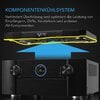pedwar
Established Member
Just wondering, has anyone here ever played with adding foam sealant strips to the bottom of their AC Infinity cooler to create a better seal against the AVR? I got the idea from another forum/member and was wondering if it would reduce fan noise coming out of the unit slightly to help keep the noise floor down in very quiet scenes.
I've tested it briefly on just the front/side areas (left the rear on the test and mine is a rear exhaust unit) but am undecided on the results without being able to see the internal AVR temp.
Results
While leaving the 'Smart' setting to 32c on my setup the 'probe' temp on the cooler sits at 33c and the fan speed runs constantly at 2.
Without the foam strip the cooler 'probe' sits at about 29-30c so the smart fan speed floats between speed 1 and 2........
Why am I undecided?
Why am I undecided as you would think 'Oh no.. the better seal is trapping heat in the AVR and causing the temp to be slightly higher and the fan to run more' BUT... I'm actually wondering if what it's doing is picking up the heat of what's in the AVR better as its' sucking out the warm air more and not picking up the cooler air from the 6mm gap that normally sits all around the cooler & AVR.
To the touch the front and side casings on the AVR are cooler with the rubber seal on there.
I've removed the strips for now to put it back to standard, but I might try and get an IR temp gun on there at some point as the father in law has one (although again that's just casing temp not internals).
What are others thoughts?
(My AVR is a Denon so I know they run warm, and in an ideal world I know it shouldn't need extra cooling but it does get a little warm in the corner of the room sometimes so the AC Infinity takes the edge off. I don't run it on crazy speeds as 32c seems to be the sweet spot for it to float around it's 'smart' mode on the low fan speeds (I measured v.high 40s on top before getting a cooler and some external amplification and I'm sure it has no doubt been a little hotter with spirited listening sessions in the past). and yes there is a decent amount of air space around the unit. )
)
I've tested it briefly on just the front/side areas (left the rear on the test and mine is a rear exhaust unit) but am undecided on the results without being able to see the internal AVR temp.
Results
While leaving the 'Smart' setting to 32c on my setup the 'probe' temp on the cooler sits at 33c and the fan speed runs constantly at 2.
Without the foam strip the cooler 'probe' sits at about 29-30c so the smart fan speed floats between speed 1 and 2........
Why am I undecided?
Why am I undecided as you would think 'Oh no.. the better seal is trapping heat in the AVR and causing the temp to be slightly higher and the fan to run more' BUT... I'm actually wondering if what it's doing is picking up the heat of what's in the AVR better as its' sucking out the warm air more and not picking up the cooler air from the 6mm gap that normally sits all around the cooler & AVR.
To the touch the front and side casings on the AVR are cooler with the rubber seal on there.
I've removed the strips for now to put it back to standard, but I might try and get an IR temp gun on there at some point as the father in law has one (although again that's just casing temp not internals).
What are others thoughts?
(My AVR is a Denon so I know they run warm, and in an ideal world I know it shouldn't need extra cooling but it does get a little warm in the corner of the room sometimes so the AC Infinity takes the edge off. I don't run it on crazy speeds as 32c seems to be the sweet spot for it to float around it's 'smart' mode on the low fan speeds (I measured v.high 40s on top before getting a cooler and some external amplification and I'm sure it has no doubt been a little hotter with spirited listening sessions in the past). and yes there is a decent amount of air space around the unit.
